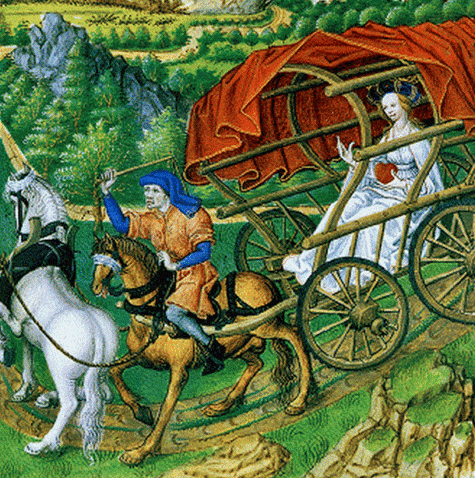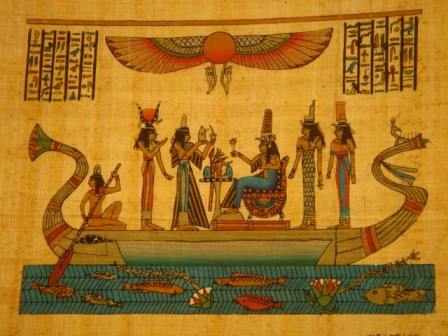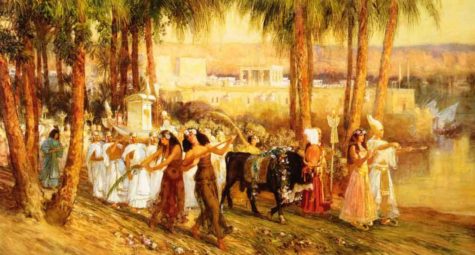Monthly Archives: March 2017
Celebrating John Chapman, legendary American pioneer and folk hero who planted apple trees across the American Frontier. Chapman was born in Massachusetts, September 26, 1774, but Johnny Appleseed Day is celebrated on March 11th.
Chapman earned his nickname because he planted small orchards and individual apple trees during his travels as he walked across 100,000 square miles of Midwestern wilderness and prairie. He was a genuine and dedicated professional nurseryman, known for his generous nature, his love of the wilderness, his devotion to the Bible, his knowledge of medicinal herbs, his harmony with the Indians, and his eccentric nature, too.
Celebrate this holiday by doing something with apples. Decorate with images of apples, apple trees, and Johnny Appleseed himself. You might visit an orchard to pick apples, hold a pot luck feast with apple smoked pork and apple pie. You might even want to plant an apple tree in your yard.
Here is a blessing you can use:
Apples are sacred
As everyone must know.
We remember Johnny
Wherever apples grow.
So we say a blessing
Wherever they may be
Blessing on the apples
And Blessing on each tree.
~Elizabeth Barrette
About Johnny Appleseed
While the legend depicts Johnny Appleseed as a barefoot vagrant, cooking pot on his head, and roaming the landscape strewing apple seeds randomly, it is far more likely that he was more of an eccentric but skilled professional, establishing nurseries of apple trees, and selling his services progressively westward to landowners interested in planning orchards. He’d teach his clients how to establish an orchard, how to keep deer and livestock at bay, and once the nursery was thriving, he’d move on to the next person interested in planting orchards.
If he had to stay in one place for any length of time, he’d erect a teepee like structure and live humbly on the bare ground. It is said that his only possessions were the clothes on his back, a bowl and a spoon, and a cooking pot for his gruel.
He was a follower of Swedenborg and devoutly believed that the more he endured in this world the less he would have to suffer and the greater would be his happiness hereafter—he submitted to every privation with cheerfulness and content, believing that in so doing he was securing snug quarters hereafter.
In the most inclement weather he might be seen barefooted and almost naked except when he chanced to pick up articles of old clothing. Notwithstanding the privations and exposure he endured, he lived to an extreme old age, not less than 80 years at the time of his death—though no person would have judged from his appearance that he was 60. He always carried with him some work on the doctrines of Swedenborg with which he was perfectly familiar, and would readily converse and argue on his tenets, using much shrewdness and penetration.
Next time you bite into an apple, think of “Johnny Appleseed.”
From Almanac.com
This is the name given to two festivals held in ancient Boeotia, which was a part of Greece, in honor of the reconciliation of Hera and Zeus. The dates of these festivals are somewhat nebulous and varied from place to place and year to year. One source cites March 10th.
The story:
According to the myth, Hera and Zeus quarreled and Hera went away to Euboea and refused to return to his bed. To trick her into coming back and on the advice of Cithaeron, Zeus dressed up a carved oak-trunk to resemble a bride and let it be known that he planned to marry Plataea, the daughter of Asopus. Hera was so angry she tore the clothes from the statue, discovered the deception, and was so pleased that the two were reconciled.
The festivities:
The Lesser Daedala (Δαίδαλα μικρά) was held every four to six years. The people of Plataea went to an ancient oak grove and exposed pieces of cooked meat to ravens, attentively watching upon which tree any of the birds, after taking a piece of meat, would settle. Out of this tree they carved an image, and having it dressed as a bride, they set it on a bullock cart with a bridesmaid beside it. The image seems then to have been drawn to the bank of the river Asopus and back to the town, attended by a cheering crowd.
After fourteen of these cycles (approx.59 or 60 years), the Greater Daedala (Δαίδαλα μεγάλα) was held, and all Boeotia joined in the celebration. At its start one wooden figure was chosen from the many that had accumulated through the years and designated the “bride”. The wooden figure was prepared as a bride for a wedding, ritually bathed in the Asopus, adorned and raised on a wagon with an attendant. This wagon led a procession of wains carrying the accumulated daedala (all the other images that had been created over the years) up to the summit of Mount Kithairon, where a wooden sacrificial altar was erected out of square pieces of wood.
This was covered with a quantity of dry wood, and the towns, persons of rank, and other wealthy individuals, offered each a heifer to Hera and a bull to Zeus with plenty of wine and incense, while at the same time all of the daedala were placed upon the altar. For those who did not possess sufficient means, it was customary to offer small sheep, but all these offerings were immolated in a hecatomb in the same manner as those of the wealthier persons. The fire consumed both offerings and altar
An ancient account of myth behind the festival is related by Pausanias:
“Hera, they say, was for some reason or other angry with Zeus, and had retreated to Euboia. Zeus, failing to make her change her mind, visited Kithairon, at that time despot in Plataea, who surpassed all men for his cleverness. So he ordered Zeus to make an image of wood, and to carry it, wrapped up, in a bullock wagon, and to say that he was celebrating his marriage with Plataia, the daughter of Asopus. So Zeus followed the advice of Kithairon.
Hera heard the news at once, and at once appeared on the scene. But when she came near the wagon and tore away the dress from the image, she was pleased at the deceit, on finding it a wooden image and not a bride, and was reconciled to Zeus. To commemorate this reconciliation they celebrate a festival called Daidala, because the men of old time gave the name of daidala to wooden images… the Plataeans hold the festival of the Daidala every six years, according to the local guide, but really at a shorter interval.
I wanted very much to calculate exactly the interval between one Daedala and the next, but I was unable to do so. In this way they celebrate the feast.”
Found at Wikipedia
March 12th, is the Feast of Marduk, an ancient Babylonian God. Acknowledged as the creator of the universe and of humankind, the god of light and life, and the ruler of destinies, he rose to such eminence that he claimed 50 titles.
The epic poem Enûma Elish tells the story of Marduk’s birth, heroic deeds and becoming the ruler of the gods. Also included in this document are The Fifty Names of Marduk. You can read more about Marduk at The Powers That Be.
Aside from being a fertility god and god of thunderstorms, Marduk’s original character is obscure. Later he became connected with water, vegetation, judgment, and magic. He is normally referred to as Bel “Lord”, also bel rabim “great lord”, bêl bêlim “lord of lords”, ab-kal ilâni bêl terêti “leader of the gods”, aklu bêl terieti “the wise, lord of oracles”, muballit mîte “reviver of the dead”, etc.
A Ritual for Marduk’s Feast Day:
- Colors: Light blue and grey
- Element: Air
- Altar: On a cloth of pale blue place a naked sword, three grey candles, and a loaf of bread shaped like a dragon.
- Offerings: Cut something into pieces.
- Daily meal: Fish or meat, chopped finely.
Invocation to Marduk
The warrior’s sword is clean and bright
And has two edges. So Marduk found.
Taking up the sword, he slew
The Dragon Mother Tiamat
And from her body carved the earth
And the overarching sky.
Yet he found, as we all do,
That he could not live anywhere
On this the new earth without
Remembering her, and all that she was,
And he lived and died surrounded
By her at the last,
And her body took his
When at last he was betrayed.
Beware, ye who would be king
By force of arms! Your enemies define you,
So choose them well.
(One who has been chosen to do the work of the ritual takes up the sword and cleaves the bread dragon into pieces, which are then passed around and eaten. Exit to the beating of a drum.)
From: Pagan Book of Hours
Traditionally the feast lasted for twelve days:
Five thousand years ago, in the cradle of Western civilization that lay between the rivers Tigris and Euphrates that we now call Iraq, the ancient Babylonians and Sumerians held their New Year celebrations at about the time of the Spring Equinox. These Mesopotamians (a word that means ‘[dwellers of the land between the rivers’), the Babylonians to the north and the Sumerians further to the south called this festival, respectively, Akitaand Zagmuk (or Zakmuk).
On the first three days, the priests would come to the high Temple of Marduk in Babylon, the Ésagila, and offer prayers of lamentation and supplication. These prayers were repeated on the fourth day, when the Enûma Eliš, the great Babylonian Epic of Creation, was recited, telling the story of Marduk’s victory over Tiamat.
On the fifth day, the king of Babylon came to the Ésagila, was stripped of his crown, robes and regalia, and was humiliated by the High Priest, who struck him in the face, symbolizing submission before the greater power of the god, after which his crown was returned, symbolizing the god’s approval of his royal and civic roles.
Marduk is then captured by the evil gods and held prisoner by them, in the Etemenanki, a seven-storey ziggurat (identified in the Torah and the Bible as the Tower of Babel), where he awaits the arrival of his son, Nabu. He arrives on day six, symbolized by a great, formal procession of the King and the citizens of Babylon to the Ésagila, and on day seven, Nabu frees his embattled father.
The eighth day saw the gathering of the statues of the gods in the hall of Destinies, where they bestow their powers on Marduk, confirming his primacy over them all. A victory procession to the House of Akita, situated outside the city walls, took place on the ninth day, as the populace celebrated Marduk’s defeat of Tiamat, and on the tenth day, Marduk returns to earth during the night and marries the goddess Ishtar, their roles acted by the King of Babylon and the High Priestess of the Ésagila.
The eleventh day sees the return to the hall of Destinies, where the gods and Marduk renew their covenant with mankind before they return to Heaven, and on the final day, the statues of the gods were returned to their places in the Ésagila and the king would be slain, so that his spirit could assist Marduk – although, in reality, a criminal would be elected as a proxy king and killed in place of the true king.
Note:
We can see here clear parallels here with the Lord of Misrule, a substitute king who takes over the responsibilities of the real king at the festival time, as well as story of Jesus and Barabbas in the New Testament, (Barabbas means, literally, ‘Son of the Lord’), and the wide-spread legends of the dying god who returns to life.
The twelve days of Zagmuk are the origins of our twelve days of Christmas, although moved from the Babylonian New Year to our New Year, and they may well be the intercalary adjustment of 11.25 days needed to reconcile the 354 days of the lunar year with the 365.25 days of the solar year.
The names and the mythology of Marduk were also incorporated into the fictional mythology of the Necronomicon. Each of the fifty names was given a power and a seal. These can be found here: About The Fifty Names of Marduk
Source: Wikipedia and The Study
The Festival of Navigation (March 5th) was an ancient Roman festival that celebrated Isis as the ruler over safe navigation, boats, fishing, and the final journey of life. At this festival, after an elaborate parade, a Ship of Isis filled with great offerings of incense, flowers, libations and small shrines was sent out to sea.
For an eyewitness description of this festival, visit this post: Navigium Isidis.
I do like the idea of sending out ships with offerings to Isis. And with that in mind, I’m sharing here a video tutorial on how to make a paper boat that floats on water. This small boat could be decorated with symbols or with petitions for guidance, filled small offerings, and then floated down a stream, creek, river, etc. If you don’t have access to water, you could ritually burn your boat on a bed of incense and fragrant herbs and allow the smoke to take your petitions and offerings to the goddess.
When Egypt became part of the Roman Empire, Greek merchants brought the worship of Isis from Alexandria to Rome and invoked Her as inventor of the sail, patron of navigation, and ruler of the waves.
Possibly the most well known Isiac festival of the Roman world was the Navigium Isidis, celebrated on the 5th of March. As part of the festivities, a a festive carnival procession was performed in honor of Isis, and the Vessel of Isis, laden with offerings of precious spices and milk libations, is launched.
Here is a colorful and detailed eye-witness account of the procession and the ceremony:
Soon the sun of gold arose and sent the clouds of thick night flying; and lo, a crowd of people replenished the streets, filing in triumphal religious procession. It seemed to me that the whole world, independent of my own high spirits, was happy. The dusky clouds were routed; and the heavens shone with clear sheer splendor of their native light.
Presently the vanguard of the grand procession came in view. It was composed of a number of people in fancy dress of their own choosing; a man wearing a soldier’s sword-belt; another dressed as a huntsman, a thick cloak caught up to his waist with hunting knife and javelin; another who wore gilt sandals, a wig, a silk dress and expensive jewelry and pretended to be a woman.
Then a man with heavy boots, shield, helmet and sword, looking as though he had walked straight out of the gladiators’ school; a pretended magistrate with purple robe and rods of office; a philosopher with cloak, staff, clogs and billy-goat beard; a bird catcher, carrying lime and a long reed; a fisherman with another long reed and a fish hook.
Oh, yes, and a tame she-bear, dressed like a woman, carried in a sedan chair; and an ape in a straw hat and a saffron-coloured Phrygian cloak with a gold cup grasped in its paws – a caricature of Jupiter’s beautiful cup-bearer Ganymede.
Finally an ass with wings glued to its shoulders and a doddering old man seated on its rump; you would have laughed like anything at that pair, supposed to be Pegasus and Bellerophon. These fancy-dress comedians kept running in and out of the crowd, and behind them came the procession proper.
At the head walked women crowned with flowers, who pulled more flowers out of the folds of their beautiful white dresses and scattered them along the road; their joy in the Saviouress appeared in every gesture.
Next came women with polished mirrors tied to the backs of their heads, which gave all who followed them the illusion of coming to meet the Goddess, rather than marching before her.
Next, a party of women with ivory combs in their hands who made a pantomime of combing the Goddess’s royal hair, and another party with bottles of perfume who sprinkled the road with balsam and other precious perfumes; and behind these a mixed company of women and men who addressed the Goddess as “Daughter of the Stars” and propitiated her by carrying every sort of light – lamps, torches, wax-candles and so forth.
Next came musicians with pipes and flutes, followed by a party of carefully chosen choir-boys singing a hymn in which an inspired poet had explained the origin of the procession.
The temple pipers of the great god Serapis were there too, playing their religious anthem on pipes with slanting mouth-pieces and tubes curving around their right ears; also a number of beadles and whiffers crying: “Make way there, way for the Goddess!”
Then followed a great crowd of the Goddess’s initiates, men and women of all classes and every age, their pure white linen clothes shining brightly. The women wore their hair tied up in glossy coils under gauze head-dresses; the men’s heads were completely shaven, representing the Goddess’s bright earthly stars, and they carried rattles of brass, silver and even gold, which kept up a shrill and ceaseless tinkling.
The leading priests, also clothed in white linen drawn tight across their breasts and hanging down to their feet, carried the oracular emblems of the deity. The High Priest held a bright lamp, which was not at all like the lamps we use at night banquets; it was a golden boat-shaped affair with a tall tongue of flame mounting from a hole in the centre.
The second priest held an auxiliaria, or sacrificial pot, in each of his hands – the name refers to the Goddess’s providence in helping her devotees. The third priest carried a miniature palm-tree with gold leaves, also the serpent wand of Mercury. The fourth carried the model of a left hand with the fingers stretched out, which is an emblem of justice because the left hand, with its natural slowness and lack of any craft or subtlety, seems more impartial than the right. He also held a golden vessel, rounded in the shape of a woman’s breast, from the nipple of which a thin stream of milk fell to the ground. The fifth carried a winnowing fan woven with golden rods, not osiers. Then came a man, not one of the five, carrying a wine-jar.
Next in the procession followed those deities that deigned to walk on human feet. Here was the frightening messenger of the gods of Heaven, and of the gods of the dead: Anubis with a face black on one side, golden on the other, walking erect and holding his herald’s wand in one hand, and in the other a green palm branch. Behind, danced a man carrying on his shoulders, seated upright, the statue of a cow, representing the Goddess as the fruitful Mother of us all.
Then along came a priest with a box containing the secret implements of her wonderful cult. Another fortunate priest had an ancient emblem of her godhead hidden in the lap of his robe; this was not make in the shape of any beast, wild or tame, or any bird or human being, but the exquisite beauty of its workmanship no less than the originality of its design called for admiration and awe.
It was a symbol of the sublime and ineffable mysteries of the Goddess, which are never to be divulged a small vessel of burnished gold, upon which Egyptian hieroglyphics were thickly crowded with a rounded bottom, a long spout, and a generously curving handle along which sprawled an asp, raising his head and displaying its scaly, wrinkled, puffed-out throat…
Meanwhile the pageant moved slowly on and we approached the sea shore… There the divine emblems were arranged in due order and there with solemn prayers the chaste lipped priest consecrated and dedicated to the Goddess a beautifully built ship, with Egyptian hieroglyphics painted over the entire hull; but first he carefully purified it with a lighted torch, an egg and sulphur. The sail was shining white linen, inscribed in large letters with the prayer for the Goddess’s protection of shipping during the new sailing season.
The long fir mast with its shining head was now stepped, and we admired the gilded prow shaped like the neck of Isis’s sacred goose, and the long, highly-polished keel cut from a solid trunk of citrus-wood. Then all present, both priesthood and laity, began zealously stowing aboard winnowing-fans heaped with aromatics and other votive offerings and poured an abundant stream of milk into the sea as a libation.
When the ship was loaded with generous gifts and prayers for good fortune, they cut the anchor cables and she slipped across the bay with a serene breeze behind her that seemed to have sprung up for her sake alone. When she stood so far out to sea that we could no longer keep her in view, the priests took up the sacred emblems again and started happily back towards the temple, in the same orderly procession as before.
On our arrival the High Priest and the priests who carried the oracular emblems were admitted into the Goddess’s sanctuary with other initiates and restored them to their proper places. Then one of them, known as the Doctor of Divinity, presided at the gate of the sanctuary over a meeting of the Shrine-bearers, as the highest order of the priests of Isis are called. He went up into a high pulpit with a book and read out a Latin blessing upon “our liege lord, the Emperor, and upon the Senate, and upon the Order of Knights, and upon the Commons of Rome, and upon all sailors and all ships who owe obedience to the aforesaid powers.”
Then he uttered the traditional Greek formula, “Ploeaphesia”, meaning that vessels were now permitted to sail, to which the people responded with a great cheer and dispersed happily to their homes, taking all kinds of decorations with them; such as olive boughs, scent shrubs and garlands of flowers, but first kissing the feet of a silver statue of the Goddess that stood on the temple steps.
From: The Golden Ass
March 4th was the Greek festival of the Anthesteria, which was a celebration of flowers and dedicated to Flora. To celebrate this Spring festival of flowers, buy fresh flowers for your home. If you have house plants, repot and fertilize them. Burn a flowery incense, such as jasmine, rose or honeysuckle. Wear pastel colors to represent the delicate shades of the new Spring blossoms. Place a pretty bowl of fresh water on your altar and float a light flower in it.
When the moon is up, go to your altar and light a white candle. Sit in the darkness with only the candlelight. Look at the floating flower and think about the wonderful powers of Nature that bring the flowers back year after year. Contemplate the way this power touches your own life.
Feel your “roots” sinking deep down into the Earth, from which you can draw sustaining energy. Feel the energy being fed back to you. Now, reach your arms upward toward the Moon. Feel its energies adding to those of the Earth. Let these energies swirl around and through you, cleansing, healing, balancing. To break the flow, place both hands on the floor. Let the energies sink back into the Earth.
From: Moon Magick
This month was sacred to the Roman god Mars, hence the name March. Mars is similar to the Greek Ares, Tiu or Twaz of Central and Northern Europe, Teutates of the Celts, and Tyr of the Norse. The Roman goddess Bellona, goddess of war, had her special day during this month.
March is generally a blustery month weather-wise. The old weather saying “In like a lion, out like a lamb” is an apt description of March weather. For the Romans, it was the beginning of their year. The Spring Equinox, which falls around March 21 or 22, was a sacred and celebrated time in a great many world cultures. In the Southern Hemisphere, this would be equal to the Autumn Equinox, as the seasons are reversed. The Incas celebrated Pacha-puchy, or Earth Ripening, at this time.
The Roman Matronalia honored Juno Lucina, an aspect of the goddess Juno, who protected women, children and the family. Statues of the goddess were decorated with flowers, and special temple fires were lit. Girls made offerings to Juno Lucina at this time of year for happy and prosperous marriages.
The statue of Isis suckling her child symbolizes this goddess’s aspect as the Great Mother, the caretaker of the Earth and all life. Flowers were floated on the rivers and the boats blessed with incense.
In Canaan and other Semitic countries, the goddess Astarte was honored in a Spring celebration. Red eggs were given as gifts to family and friends, the beginning of our Easter egg tradition. Her sacred city of Byblos was noted for its extensive libraries before they were destroyed. As queen of heaven, Astarte wore crescent horns and was said to tirelessly create and destroy. The kings of Sidon ruled only with the goddess’s permission and called themselves the Priest of Astarte. Other cultures in the Middle East knew Astarte as Asherat of the Sea and Astart, queen of heaven.
Athene/Minerva,the armed goddess of wisdom,reigned over the biggest social event in Greece – the five day Spring competition featuring events in athletics, music, poetry and satire. Crowns of olive branches and flasks of olive oil were given to the winners of each event. On the final day, Athene’s birth was celebrated by draping the goddess’s statue in a new sacred garment.
This particular festival of Cybele, the Hilaria, was a happy time. Our word “hilarious” has similar word roots. The goddess Cybele can be compared to Demeter in many ways; Cybele represented the Earth as did Demeter and had a Spring resurrected son/lover Attis, who corresponded to Kore/Persephone. This happy festival celebrated the power of Cybele to overcome death.
Eostre was the German goddess of rebirth. Rabbits and colored eggs were fertility symbols connected with Her. Originally, Oestre was the goddess of the Spring Equinox whose name was changed to Easter by the Christians.
The Roman Luna, goddess of the Moon, was honored with the baking, exchanging, and eating of Moon cakes. Even the Chinese and Europeans knew of Moon cakes and some form of this goddess.
From: Moon Magick
Amaolikkervik Moon ~Inuit
Big Famine Moon ~Choctaw
Bud Moon ~Kiowa
Budding Trees Moon ~Medicine Wheel
Buffalo Calf Moon ~Arapaho, Sioux
Catching Fish Moon ~Agonquin
Chaste Moon ~Medieval English
Crow Moon ~Algonquin
Crane Moon ~Potawatomi
Crust Moon ~Algonquin
Deer Moon ~Natchez
Death Moon ~Neo-Pagan
Eagle Moon ~Cree
Fish Moon ~Colonial American
Green Moon ~Pima
Lenten Moon ~Cherokee
Little Frog Moon ~Omaha
Little Spring Moon ~Creek, Muscokee
Lizard Moon ~San Juan
Long Days Moon ~Wishram
Moon of Winds ~Celtic
Moose Hunter Moon ~Abenali
Much Lateness Moon ~Mohawk
Rain Moon ~Diegueno
Plow Moon ~Janic (full)
Sap Moon ~Algonquin
Seed Moon ~Janic (dark)
Snow Crust Moon ~Anishnaabe
Snow Sore Eyes Moon ~Dakota
Spring Moon ~Passamaquoddy
Strawberry ~Cherokee
Sugar Moon ~Algonquin
Whispering Wind Moon ~Hopi
Wind Strong Moon ~Taos
Windy Moon ~Cherokee
Worm Moon ~Algonquin
Holy Wells Day is a day dedicated to Caedda, the Celtic goddess of healing springs and wells.
Ceadda, an Old English Goddess of healing springs and wells, enjoys her holy day of celebration on March 2. While Her place in the hearts of the people has since been appropriated by St. Chad of Mercia, Catholic patron saint of wells, those of us who follow the old ways may care to pay homage to Ceadda today.
To lend energy to this maiden Goddess, visit a natural spring or well. Tidy up the grounds by picking up any refuse that you see on the ground, and leave a small gift of organic flowers or fruit near the water. Naturally sweet gifts are appropriate, as are organic cotton ribbons to bedeck the well.
Saying a few words for Ceadda is also appropriate. Speak from your heart, either out loud or silently, and tell Her how grateful you are for the living waters that spring from the Earth to heal and nourish us. If you wish, you may use this prayer:
Ceadda, Lady of healing waters,
Hear my grateful voice.
Please receive my gift of _______
In acknowledgement of your Divine work
Thank you for protecting and keeping the sacred springs and wells
I pay You homage and remember You
Sources: The Pagan Book of Days
A wonderful spiced and fruited cake which heralds the advent of Spring, simnel cake has a fascinating cultural heritage with roots that stretch back to the Romans and Athenians. In Britain, known as the Shrewsbury Simnel, it is simply made using white flour, fragrant spices and is generously studded with dried fruits and pungent peel.
Like a Christmas cake, it is covered with pale sweet almond paste. The decoration is plain – twelve little balls of smooth paste. A specially baked simnel cake is a wonderful gift to take to your mother for Matronalia, Mother’s Day, or Mothering Sunday Tea Time. Decorate it with crystalised flowers and tie some yellow ribbon around the side.
Ingredients:
For the almond paste:
- 400 g icing sugar, sifted
- 250 g ground almonds
- 1 large egg yolk, beaten lightly
- 3-4 tablespoons orange juice
- 5 drops almond essence
For the cake :
- 250 g plain flour
- 1 pinch salt
- 1 teaspoon nutmeg
- 1 teaspoon cinnamon
- 280 g currants
- 250 g sultanas
- 110 g mixed peel
- 160 g butter
- 160 g caster sugar
- 3 large eggs
- 200 ml milk, to mix
You will also need:
- a sifter,
- nest of bowls,
- food processor or electric beater,
- spatula,
- wooden spoon,
- 24 cm round cake tin,
- baking paper,
- brown paper and twine,
- rolling pin,
- thin metal skewer.
To make your own almond paste you will need:
- a food processor fitted with a steel blade.
- Don’t be tempted to use store-bought almond paste because it contains lots of sugar and few almonds, it will turn to liquid under the grill.
Directions:
Place icing sugar and almonds in food processor bowl. Process, slowly dripping in egg yolk, orange juice and almond essence. The mixture should form a pliable paste. Set aside a small portion for balls with which to decorate the cake. Roll out the remaining paste into 2 circles which are the approximate size of the tin. Set aside.
Preheat oven to 160°C/320°F.
Use a sturdy non-stick cake tub or line the buttered base with baking paper. As the baking period is long (1-1 1/2 hours), prevent the cake drying out by wrapping a double thickness of brown paper around the pan and securing it with twine.
Sift flour, salt and spices together, then stir in fruit and peel. Cream butter and sugar thoroughly until light and creamy then beat in eggs one at a time, until the mixture is fluffy. (Reserve a drop of egg yolk for brushing over top layer of almond paste.). Stir flour and fruit into creamed mixture (you may need to add a little milk to give the mixture a dropping consistency).
Place half the mixture into a greased and lined cake tin. Place one pre-rolled round of almond paste over the top. Cover with remaining cake mixture. Before baking the cake, give the pan of mixture a sharp tap on to a firm surface. This settles the mixture and prevents holes from forming in the cake.
Bake in the center of the oven for 1-1 1/4 hours or until a thin metal skewer inserted in the center of the cake comes out without a trace of stickiness. Level the cake by placing a weighted plate on top of the cooked cake while it is still hot.
Turn out cake on to a wire rack after leaving it to settle in the cake tin for between 10 and 15 minutes. Peel off paper and leave to cool completely.
Cover the top of the cake with a second round of almond paste. Roll 12 small balls of paste and place evenly around the top of the cake. Brush the top with a little beaten egg and very lightly brown under the grill until the almond paste turns light golden brown. Remove and leave to cool.
Note from someone who tried this recipe:
I did give the pan it’s tap to get rid of air bubbles but almost had a disaster when I went to take everything off so that I could set this on a cake rack to cool.. the almond paste in the middle was still liquid and was leaking down the sides of the cake at a great rate, so I quickly shoved it as neatly as I could back into the springform and let it cool completely before loosening it again. At least my baking paper helped stem the flow before I lost it all. Some of my twelve little balls slipped off while I had this in the oven the second time… so I’d advise not to put them too near to the edge of the cake.














